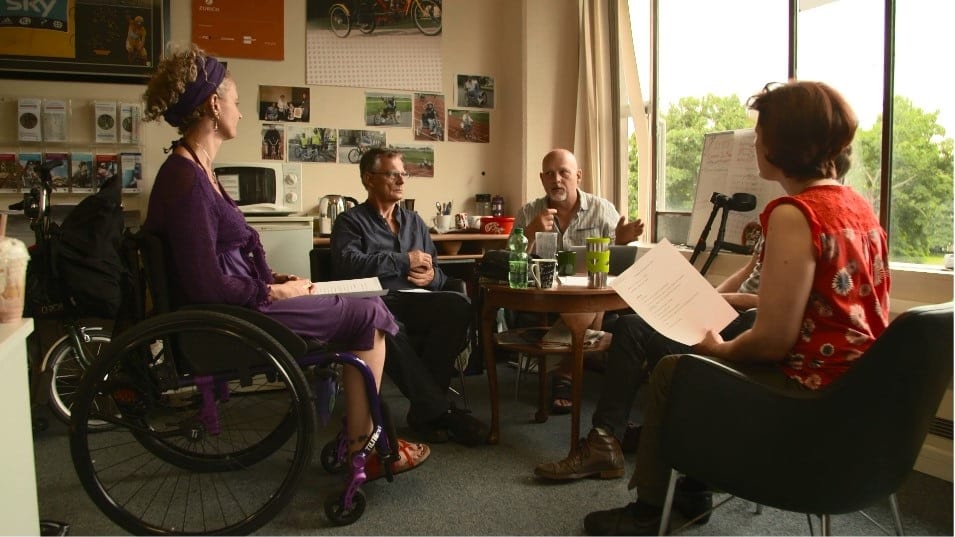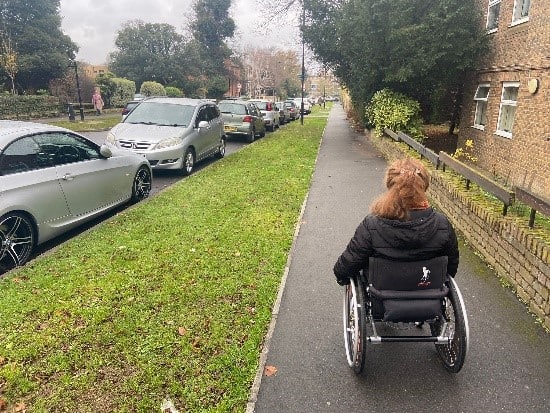Wheels for Wellbeing really likes the idea behind Low Traffic Neighbourhoods (LTNs). They’re designed to restrict traffic through residential areas and to enable more people to walk, wheel, or cycle, without preventing anyone from driving to any particular point within the neighbourhood.
But LTNs have divided opinion on social media and in real life. Some LTNs have left some Disabled people feeling trapped, ignored or abandoned, experiencing increased anxiety and stress and decreased mobility.
In this two-part blog series, we’re taking a closer look at LTNS – the Good, the Bad, and the Ugly – and consider some solutions for the future.
Welcome to part 2 of our two-part blog series on Low Traffic Neighbourhoods (LTNs). In part 1, we had a closer look at LTNs – the Good, the Bad, and the Ugly. In this second part, we’re looking at some solutions to making low-traffic streets more accessible for Disabled people.
In part one we explored some of the problems that Disabled people have encountered with LTNs. We don’t believe that the solution to the problems of LTNs is to remove them. Most LTNs are inaccessible because our streetscapes are inaccessible; simply removing an LTN will not resolve this. Any solution to the problems created by LTNs should increase accessibility, not revert to a different form of inaccessibility.
With that in mind, we’d like to suggest a few solutions and improvements:
Inclusive, accessible consultations and co-production
An LTN must work for the local community, and particularly those who have the most needs and are least able to adapt to changes. This means working with the local community to find out what the problems and possible solutions are – whether that’s adding in some dropped kerbs, changing the direction of a one-way street, or adjusting the position of a planter. Where a Disabled resident needs door-to-door vehicular transport, steps should be taken to facilitate this, such as replacing impermeable filters with permeable ones like ANPR cameras with exemptions for Blue Badge holding residents.

Roads with high traffic volumes are not accessible and do not allow the majority of the community to benefit from the physical and mental health benefits of active travel and reduced air pollution. However, traffic reduction measures must be tailored to the specific needs of those who have the most limited mobility choices in a local community.
Better Quality Pavements

If a pavement is damaged, uneven, cluttered, and lacks drop-kerbs, it is inaccessible. If the pavements are inaccessible, measures to reduce traffic will be ineffective and disproportionate for many Disabled people: if you can’t use the pavement to get there, you will have no choice but to drive, even if the distance is longer. We strongly believe that no LTN should be made permanent without a full accessibility audit of walking/wheeling environments and without adequate budgets being ear-marked for pavement upgrading.
Better access to mobility equipment
Being able to walk/wheel easily along the road will often depend on finding regular places to sit along the way / being guided by the appropriate tactile paving if you’re blind or visually impaired / having access to a wheelchair or cycle that suits your needs and knowing the pavement is accessible to you all the way to your destination etc. Funding and training should be provided to ensure that all wheelchair users are provided with a wheelchair that meets their health and mobility needs – whether that’s a powered chair that gives them the freedom to travel independently, or a light-weight outdoor wheelchair that makes physical exercise part of their everyday activity. Disabled cyclists – or would-be cyclists – need to be able to access the information and financial support to purchase a cycle that meets their particular needs.
We fully support the aim of reducing traffic, and prior experience shows that this can only be achieved via practical measures, not simple persuasion. LTNs are good tools to achieve this, but they need to be used well and with the collaboration of local residents.
However, LTNs alone are not enough. For our streets to be fully accessible, we need good-quality walking/wheeling environments and access to suitable mobility equipment for those who need it. WfW will continue to campaign to make cycling (and active travel) an accessible, affordable and fun choice for everyone.
PS: For a small but significant number of Disabled people, their impairment or health condition means they cannot journey unless they drive/are driven for the majority or entirety of their trip, for some or all of the time. They must not be ignored, and provisions should be made to enable them to continue to use the most convenient mode of door transport. This equally does not negate the fact that less traffic and cleaner air is of benefit for all.
